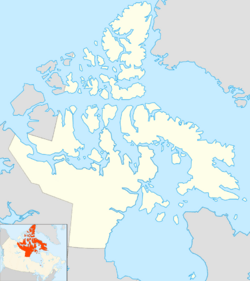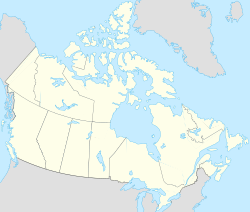Reference Island facts for kids
| Geography | |
|---|---|
| Location | Chesterfield Inlet |
| Coordinates | 63°42′N 91°55′W / 63.70°N 91.92°W |
| Archipelago | Canadian Arctic Archipelago |
| Administration | |
| Nunavut | Nunavut |
| Region | Kivalliq |
| Demographics | |
| Population | Uninhabited |
Reference Island is a small, uninhabited island located in the cold, northern parts of Canada. It is part of the vast Canadian Arctic Archipelago, a group of islands found in the Arctic Ocean. This particular island lies within Chesterfield Inlet, which is a long bay or fjord in the Kivalliq Region of Nunavut.
Reference Island is a remote place, meaning no people live there permanently. Like many islands in the Canadian Arctic, it experiences very cold temperatures for most of the year.
Where is Reference Island?
Reference Island is found in the Arctic part of Canada. It's specifically located inside Chesterfield Inlet, a large body of water that connects to Hudson Bay. This inlet is important for local communities and wildlife.
The island is part of the Kivalliq Region in Nunavut. Nunavut is Canada's largest and newest territory, known for its incredible Arctic landscapes and strong Inuit culture. The coordinates for Reference Island are about 63.70 degrees North and 91.92 degrees West. These numbers help pinpoint its exact spot on a map.
Life in the Arctic
Even though Reference Island itself is uninhabited, the surrounding Arctic environment is home to many amazing animals. Animals like polar bears, seals, and various types of birds are adapted to survive in the cold. They often rely on the sea ice and open water for hunting and travel.
The land around Reference Island is mostly tundra. Tundra is a type of biome where the ground is frozen for most of the year, called permafrost. Only small plants like mosses, lichens, and low-growing shrubs can survive here. Trees do not grow in this harsh climate.
Why are Arctic Islands Important?
Islands like Reference Island, even if small and uninhabited, are important for several reasons. They are part of the unique Arctic ecosystem. They can serve as resting or breeding grounds for birds and marine mammals.
Scientists also study these remote islands to understand climate change. Changes in temperature and sea ice in the Arctic can affect the whole planet. Studying places like Reference Island helps us learn more about our world.



